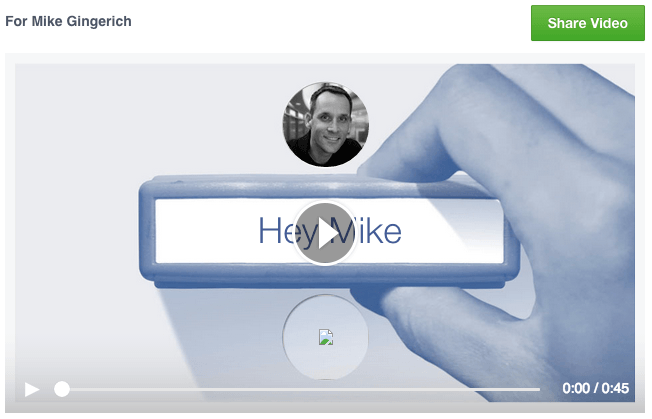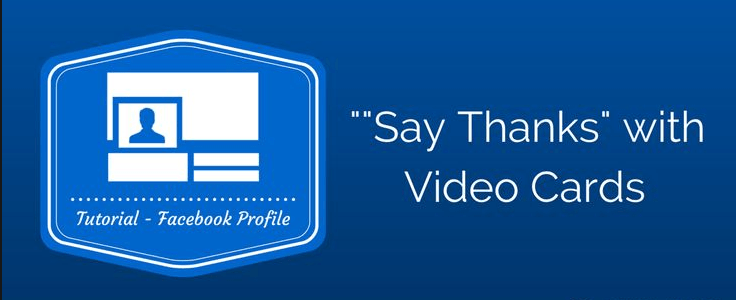 Written by ContentPowered.com
Written by ContentPowered.com
Way back in November, Facebook introduced what they called Say Thanks. The idea is pretty simple; one person wants to say thank you to another person, so they use Facebook’s little automated video creator to make a short video and send it over. It’s a personal message in video form, something a little more personal and a little more touching than a text post or picture message.
All of this goes hand-in-hand with Facebook’s driving intent to, apparently, dominate the world of video. They’re already trying to surpass YouTube in terms of views and video shares. Why not make it easier for users to make videos, as well?
How it Works
The Say Thanks feature is pretty easy to use. It starts by visiting the Thanks URL, found here. You can probably click that link and learn about all you need to know, but just in case you don’t want to, here’s what you do:
- Select a friend from your friends list. This will automatically begin the customization process for their video template. It begins with circles showing your and their profile pictures with a “hey <friend name>” message. You can click the video image to preview it right there.
- Choose a theme. For the moment, it looks like Facebook only has three themes available; Old Friends, Friends, and Family. Go ahead and preview each of them to see which fits best.
- Pick pictures and posts that have some association with both you and your chosen friend. Facebook’s algorithm to choose these is somewhat suspect, largely relying on tags and other commonalities. You can pick up to 15 photos – including pictures you upload specifically for the video – and a single text post.
- Preview the video. It has some music, it has a slideshow of your pictures and your chosen text post, and it has some basic messages to splice them up.
- Share the video. It’s posted on your timeline, with your friend automatically tagged. It’s visible for all to see, unless you limit the visibility of the post, just like you an any other post on Facebook. You can also customize the post that goes along with the video.
According to Facebook, the Say Thanks feature is most used amongst users in Brazil, with the United States and Mexico coming in second and third. Millions of these videos have been made, and as yet their impact in business is largely unused.
Personal Messages in Business
At first glance, it looks like the Say Thanks feature is designed – and pretty limited – to be personal. The messages it sends are designed to be a one to one message of gratitude, and to come from a business directed at another person seems a little out of place. Well, fortunately, you can use them for business if you apply a little creativity.
Here’s an idea; use them to say thanks for a job well done. This isn’t a business-to-customer message. It’s more of a manager-to-employee message. When an employee goes out of their way, above and beyond the call of duty, to do something that benefits the department or the company as a whole, they deserve recognition. One way to give that recognition in this era of tight deadlines and overwhelming workloads is to create a customized thank you video and share it with them. It’s a simple gesture.
Ideally, the pictures you use for the video will be pictures of the event or project they helped make a success. This is particularly useful for public events they helped organize. If no such pictures exist or are suitable for a public video, you can upload various “thanks” and “well done” appreciation images. Just don’t make it too impersonal, and definitely don’t re-use the same set of images for multiple videos to different people.
Another idea; say goodbye to an employee when they leave or retire. This, of course, has to be a parting of voluntary nature and with goodwill between the employee and the company. A valued tech leaving for greener pastures might be deserving. A 20-year veteran retiring to spend time with family certainly does. A guy from accounting who got fired certainly would not.
You can use the friend or close friend template, depending on their relationship with their department. Fill it with group pictures from their time in the office, and special farewell pictures taken for the purpose. The more personal the better. The key here is the post that accompanies the video; explain the purpose and wish them well on their way.
Client and Customer Satisfaction
Making a Facebook video to praise your employees is one thing, but you can also use the Say Thanks system to offer gratitude to customers and clients. It’s best used in a sort of B2B manner, though. Facebook doesn’t like businesses directly messaging customers; the kind of solicitation that reeks of spam would undermine the entire purpose of the Thanks program.
You can, for example, thank a prominent freelancer you’ve been working with for some time with a customized Facebook Thanks. You might not have much in the way of personal images to show, but you can showcase some of the better work they did for you. You can also turn the video into a bit of a recommendation with a “highly recommended” text post or image splashed in.
As an added bonus, you can tell the freelancer that they can use that video in conjunction with using you as a reference, if they need a reference for picking up future clients.
The Friend Debate
There’s one question you need answered before you can make moves like this, and it comes down to the etiquette of friending employees or clients on Facebook. Facebook is primarily used – personal account to personal account – as a means for friends and family to keep in touch and socialize. Despite what we marketers would like, it’s purpose as an advertising platform is secondary.
There’s already a lot of debate over whether or not employers should friend employees. On one hand, in a positive environment, it’s no different than coworkers becoming friends. On the other hand, in a less positive of downright hostile environment, it puts pressure and stress on the employee and can be seen as a sort of business stalking.
Between clients, businesses friending each other works just fine. It’s not much different from using LinkedIn for professional networking. You only run into issues if you then use “private” Facebook information for negative effects in your working relationship.
If you’re friends with your clients or employees, you can certainly make use of the Say Thanks features. If you’re not, I wouldn’t go out of my way to use them.



